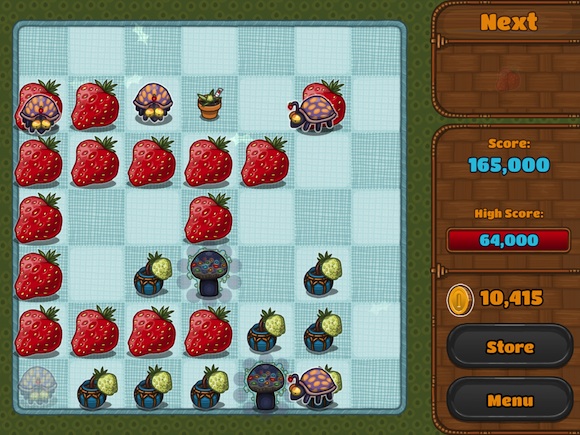For this week’s interview segment, we’ve got Geoff Blair and Matt Hackett, together they form up Lost Decade Games, who are responsible for the HTML 5-based game Lunch Bug that we reviewed recently (check it out here). These guys are really passionate about HTML 5 and indie game development. Without further ado, here we go:
Nine Over Ten 9/10: Tell us more about yourselves and how you started developing mobile games?
Geoff Blair/Matt Hackett (Lost Decade Games): The two of us (Geoff and Matt) both have web development backgrounds, working for companies like Yahoo! and Raptr. We founded Lost Decade Games in 2010 because we wanted to work on JavaScript games together. Our first game Onslaught! Arena is an award-winning HTML5 arcade shoot ’em up that we launched with the Chrome Web Store that December. In 2011, we worked with Game Closure as their very first hires, making fun game demos and helping with their SDK. In February of this year we started working on Lost Decade Games full time.
9/10: What was the idea behind Lunch Bug?
LDG: Lunch Bug was originally conceived as simple twist on the classic board game, Othello (also called Reversi). We wondered what might happen if we introduced more pieces than simply black and white. It’s evolved quite a bit from there, but you can see that the core mechanic of Lunch Bunch is still about “capturing” pieces by surrounding them with other piece types. In addition, we wanted to branch out a bit from the retro, hardcore feel of Onslaught! Arena and try our hand at a more accessible game.
9/10: How has the response been to Lunch Bug?
LDG: We’re pleased that it’s been overall very positive. Players have been saying that they like the graphics and the sound, and that once they get into the game, it offers fun and interesting problems to solve. Though, our biggest complaint has been the tutorial. It’s difficult to teach new game mechanics to players and we took a very hand-holding approach that turned off a lot of people.
This is all a learning experience for us though, and the great response to Lunch Bug has given us a lot of confidence for improving our future games.
9/10: Could you describe the process of marketing your games?
LDG: Honestly, marketing is the weakest piece of our stack. We try to get early attention on our games by tweeting and blogging about the process of making them, but it’s difficult to get many people’s attention. We do our due diligence by creating comprehensive and high-quality media kits, which we send to everyone we can in games press and journalism, but we get largely ignored.
Moving forward, we think that the issue is one of inherent interest. If a single sentence that describes a game doesn’t really grab people, it’ll probably be hard to sell marketing-wise. It can be very humbling to be composing an email to a games journalist and having difficulty coming up with a compelling reason they should spend their time writing about your game instead of hundreds of others. So in the future we’re trying to make games that people find inherently intriguing when you talk about it.
9/10: Could you share with us a little on what you’ll be working on next?
LDG: Absolutely! We recently secured funding for our next game, which we are calling Lava Blade. It’s a side-scrolling platformer built around procedural level generation and progression. It could be described as a combat-oriented Canabalt or Jetpack Joyride (or Moon Patrol for you retro gamers). It’s medieval fantasy, will be packed with content, and of course will be built in HTML5, except this time we’re tailoring the experience for desktop.
Lava Blade will be available on the open web later this year, and we’ll be making some exclusive content for Pokki, which is an HTML 5 desktop platform. Pokki also sponsors Lostcast, our HTML5 games podcast.
9/10: Any plans for releasing Lunch Bug as a native app and market it on the iTunes App Store?
LDG: Lunch Bug runs pretty well in Mobile Safari, so technically the game is playable on iOS devices. However, the game runs rather slowly and audio is just terrible in mobile browsers. We’d really like to get it on the iTunes App Store, but we’ll need to integrate with native wrapper technology like those from Ludei and Game Closure. It was actually Game Closure’s SDK that allowed us to get Onslaught! on iPad, but Ludei has also integrated one of our portal games with their SDK, and it looks really promising too. The future is bright!
9/10: Any words for aspiring game developers out there?
LDG: We suggest starting by doing everything yourself. Find a way to be as productive as you can, as fast as you can. If you know Java, go with that. If you’re not a programmer, pick some GUI like Game Maker and run with it. Design the simplest game you can, make it a complete game with a title screen and menus and all that, and wrap a bow on it. Then spend as long as you can polishing your very simple game until there’s nothing left you’d make prettier or smoother.
Once you show this creation to people, the conversations you have with professionals in the industry changes. Before you have something really compelling like a full game to play, I think people have a tendency to not take you seriously. So prove yourself and make a game! Once you’ve demonstrated a broad, valuable skillset, you can begin to focus your efforts on your specific area of interest, like design or graphics.
We often talk about making it as an independent game developer on our blog and podcast, and Matt discussed it in depth on an episode of Laser Time podcast called How to Make a Video Game.


This was fun, thanks Jason